Shingle Marsh Video
A video made by drone of the recent works digging channels and scrapes for the Shingle Marsh wilding project. Many thanks to Craig who shot the video.
A video made by drone of the recent works digging channels and scrapes for the Shingle Marsh wilding project. Many thanks to Craig who shot the video.
Here’s a little quiz question. Which famous Martha died in September 1914? One clue: she was called Martha after George Washington’s wife. Here’s another: fifty years before her death there were 10 billion others like her. Final clue: she was the last of her kind. Answer: Martha was the last ever Passenger Pigeon, once the most numerous bird on earth, and she died at 12 noon on 1 September 1914 in the Cincinnati Zoo, Ohio. It’s the best-recorded extinction in history, and perhaps the most extraordinary. Up to the mid-nineteenth century huge flocks of these birds darkened the skies of America. We hear of one in 1813 so vast that it spread from horizon to horizon and took three days to pass over. Yet in a few decades the bird was no more. What could have happened?
The main cause was simple in fact. The immigrants from Europe had poured into America and spread west, dispossessing the native Indians, clearing the land and destroying the forests as they went. The pigeons were wholly dependent on these forests for food and nesting sites. They were also easy to hunt and their flesh was both a staple diet for the settlers and a valuable export, so they were slaughtered on an industrial scale. In the killing season extra trains were put on to convey thousands of barrels of pigeon bodies east to cities like Chicago, Philadelphia, New York and Boston.
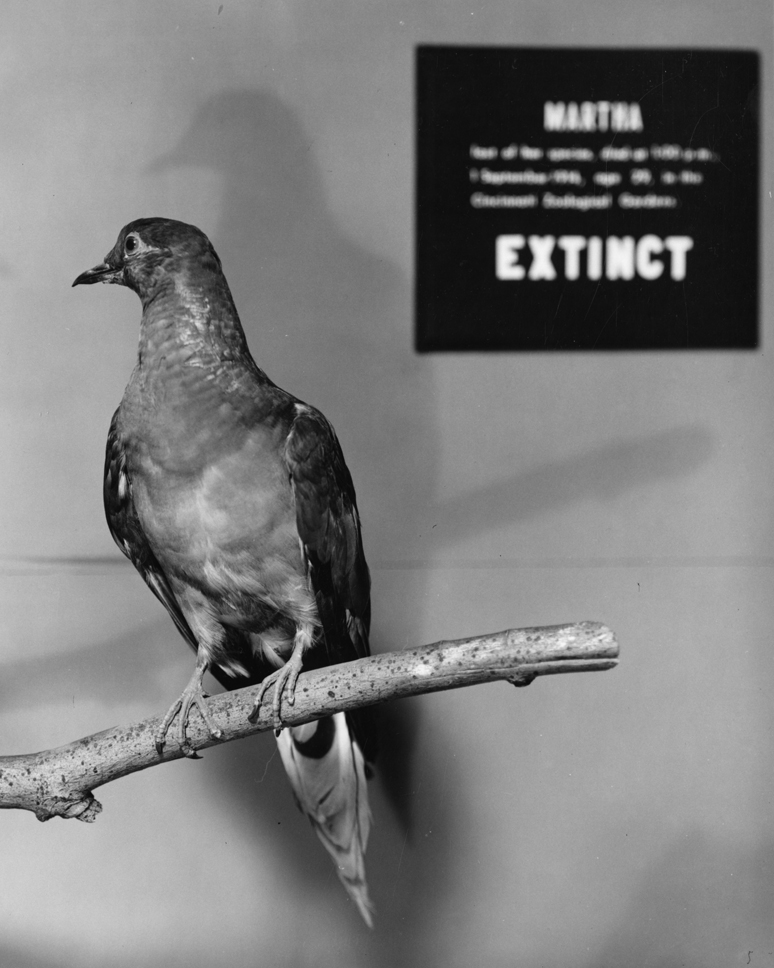
The name ‘passenger pigeon’ isn’t a macabre reference to these train journeys, but probably derives from the French pigeon de passage or some equivalent Indian name. This was a permanently mobile species, moving on restlessly until they literally ran out of forest. It should really have been called the ‘wandering pigeon’ or ‘peregrine pigeon’.
This isn’t the only extinction of a charismatic bird, of course. Think of the great auk, last recorded in Britain in St Kilda in 1840 and killed by fishermen who were terrified by its unearthly shrieking and clubbed it to death, thinking it a witch. Or the dodo, which has entered our language as the very symbol of extinction, ‘dead as a dodo’. That was a sort of giant pigeon, too, in fact. The last of them died in 1662 in Mauritius – a fat, clumsy and trusting bird which was butchered by sailors grateful for an easy meal.
It couldn’t happen again, could it? But when did you last see or hear the British cousin of the passenger pigeon, the turtle dove? That used to be the soundtrack of summer with its gentle purring song. They were common here once, but I didn’t hear one anywhere this year, or last …
Jeremy Mynott
3 September 2024
Dinosaurs are wildly popular, especially with children. Think of all those films, books, cartoons and soft toys. Is it because they belong to a world long past, full of extraordinary creatures we shall never see again? At any rate, the attraction doesn’t seem to extend to their modern-day descendants in the same family – crocodiles, snakes, lizards and iguanas. ‘Ugh, reptiles – slithery, dangerous creatures, more horror film material than Disney!’ Well, that’s partly right since they are indeed slithery – the word ‘reptile’ means ‘creeping thing’ but in Britain, at least, only one of them (the adder) is at all poisonous, while the others are entirely benign and all of them are interesting.
We have six species of reptiles in this country – so there’s a quiz question, can you name all six? They comprise three snakes, two lizards and one other that looks somewhat like a snake but is actually a legless lizard – a slow worm. You can tell a slow worm from a snake since it has eyelids and can blink. It also has a much smoother skin, in which the scales are not overlapping and don’t feel rough to the touch. Finally, slow worms have no separate ‘neck’ so do indeed look like a very long worm.
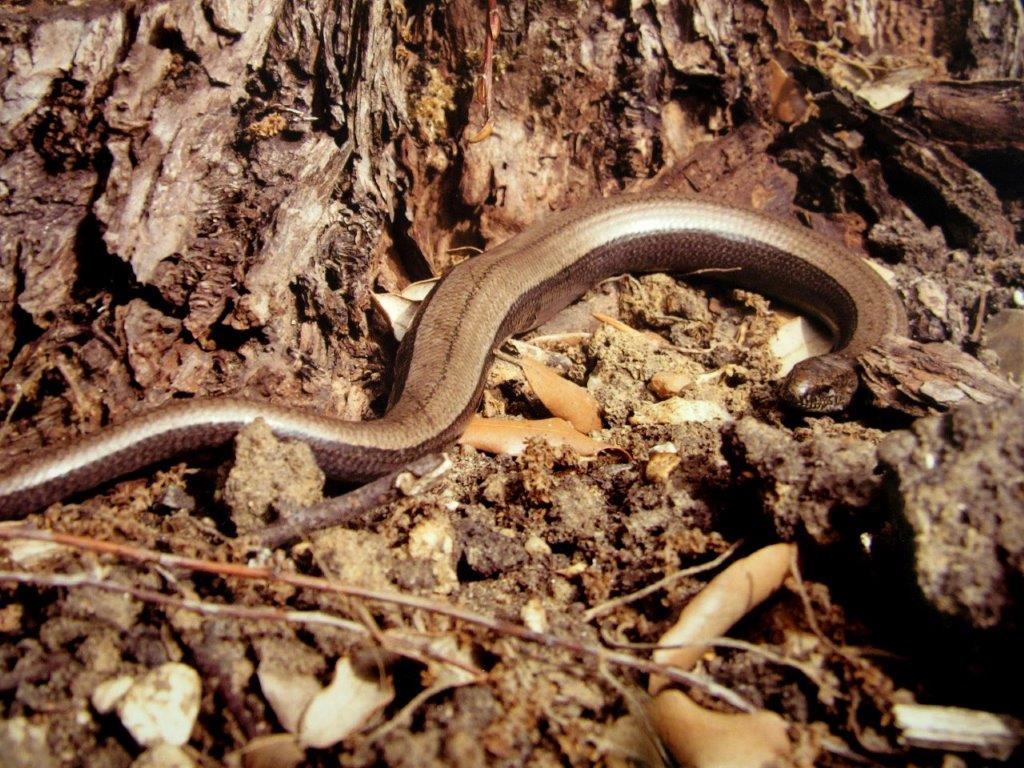
There have always been popular misconceptions about slow worms. Shakespeare usually gets his wildlife references right but in Macbeth he has the witches casting a ‘blind worm’s sting’ into their toxic brew, a double error since they are neither blind nor do they sting. They do have one unusual anatomical feature, however, which accounts for their scientific name fragilis. They have various natural enemies like hedgehogs, badgers, magpies and domestic cats and have evolved a trick whereby if the would-be predator grabs them by the tail they can detach these and leave their captors grasping just this bony appendage – still wriggling independently. If they survive all these hazards, slow worms can live to a great age – over 50 years has been recorded. They also enjoy an impressive sex life, in which a couple can be entwined together mating in leisurely fashion for some ten hours at a stretch, so to speak.
Slow worms used to be quite common round here, and were welcome garden visitors, feeding on slugs and snails and living unobtrusively in damp corners and under compost heaps, but their numbers have declined sharply in recent years. Help may be at hand, however. A local developer needs to relocate some from a building site before he can get permission to proceed and we’ve made a bid for them. So there could be some coming your way, slowly of course.
Jeremy Mynott
6th August 2024
There’s a 1989 film called ‘Field of Dreams’ in which an Iowa farmer (Kevin Costner) converts one of his corn fields into a baseball stadium to relive memories of his childhood sporting heroes. ‘Build it and they will come’, he hopes, and so they do. There is a conservation equivalent to this in the ambitions of bodies like the RSPB, which acquire tracts of former farmland in the hope that our threatened wildlife will return to populate it. ‘Save it and they will come’ is their corresponding motto. In 1948, the RSPB bought Havergate Island (the only island in Suffolk) to protect the first nesting avocets to have returned to Britain since the mid-nineteenth century. That too was a huge act of faith, but the avocets flourished and the site went on to attract a huge range of other wildlife including, most recently and excitingly, a colony of nesting spoonbills. It was a similar story at RSPB Lakenheath, where since 1995 they have transformed the former carrot fields into a major wetland reserve which now has breeding bitterns, marsh harriers and cranes.
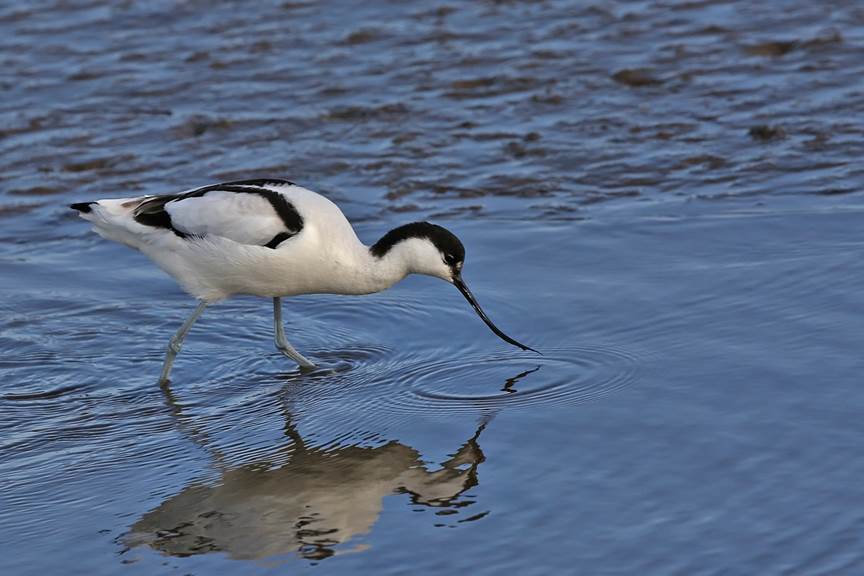
These are both spectacular success stories, but we can all do our bit on a much smaller scale. The residents of Shingle Street have just embarked on a modest community venture of this kind. We have acquired an adjacent field, which was poor-quality grazing land, and are planning to turn part of it into a wetland. Shingle Marshes, as we are calling it, is already home to skylarks, snipe and brown hares, but we plan to restore some ancient lagoons and channels to create new habitats for visiting waders and wildfowl – curlew, godwit, lapwing, teal and wigeon, maybe even a breeding avocet of our own one day. We will also encourage a spread of fringing reeds for nesting warblers, reed buntings and (in my dreams) bittern, as well as water voles, harvest mice, dragonflies and rare aquatic invertebrates like the starlet sea-anemone. The overall aim would be to protect what is already there and to restore the biodiversity of local species we have sadly lost over the years.
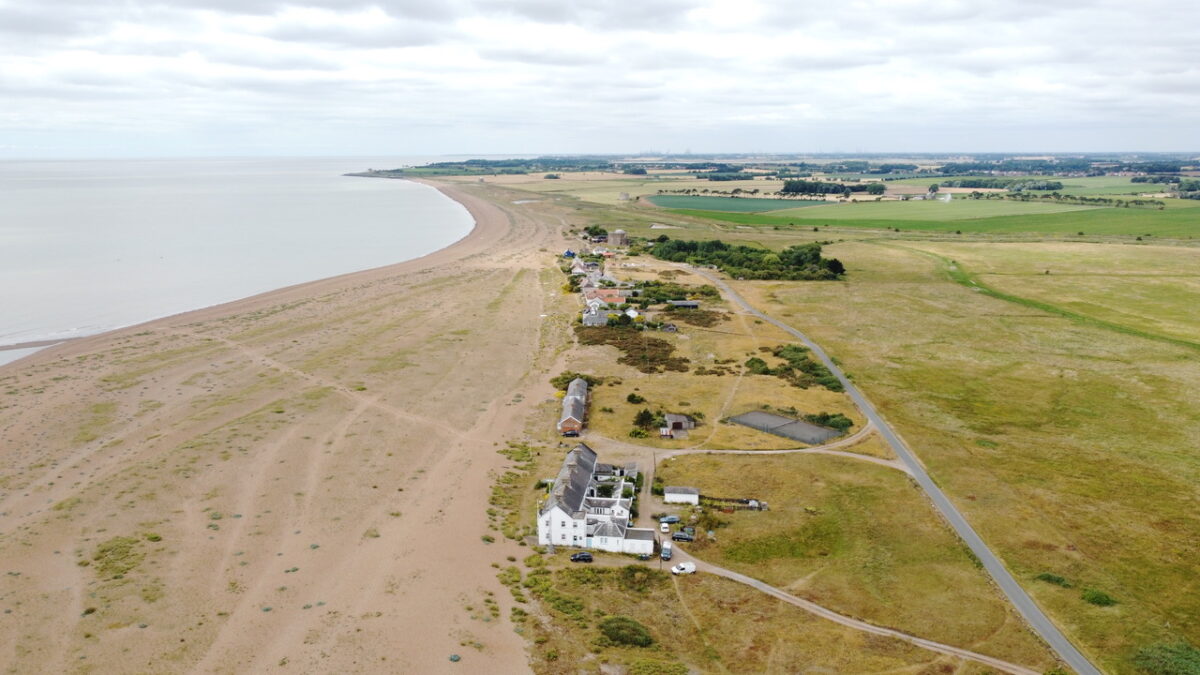
There is, however, also a second important conservation motto. We must not only ‘Save it so they will come’, but then ‘Leave well alone’ if they do. The whole field is readily visible from the road and sea-walls, but we shall need to protect it from any closer access by people and their dogs lest we end up destroying what we have just created. In the words of the poet Gerard Manley Hopkins:
O let them be left, wildness and wet.
Long live the weeds and the wilderness yet
Jeremy Mynott
February 2024
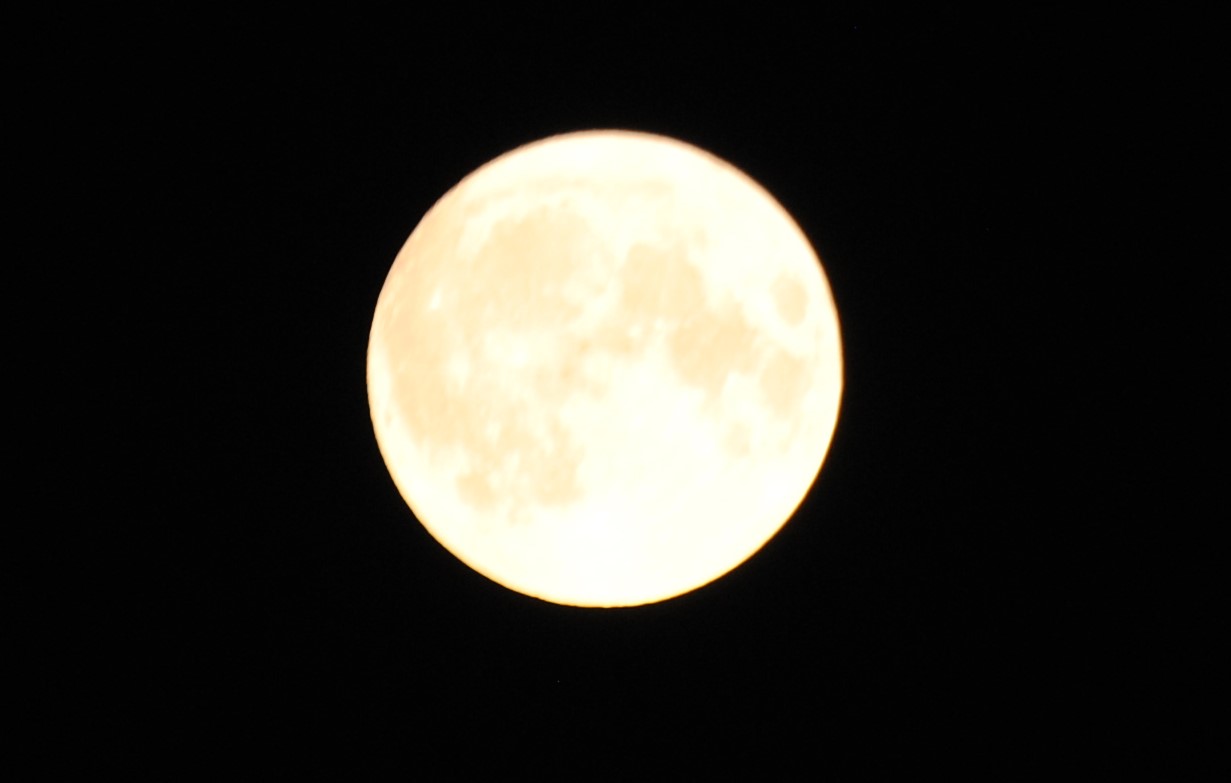
Saturday 7th October 2023
Hoffman Building, Snape Maltings Concert Hall, Snape Bridge, Snape IP17 1SP.
Informal drop in 11.30pm to 1pm
Presentations and Q&A 2pm to 4pm
The East Suffolk Water Management Board, The Alde & Ore Estuary Trust and the Alde & Ore Community Partnership are delighted to host an informal opportunity to chat about plans for increasing the resilience of the estuary flood defences against a catastrophic flood. This will include the progress of the Upper Estuary works and the development of the business case for the Lower Estuary.
The team will be there from 11.30am to 1pm to discuss the whole estuary approach.
Then, in the afternoon, from 2pm to 4pm we will be presenting an overview, exploring the project links and interdependencies between the Upper and Lower Estuary. We will outline of the work of The Alde & Ore Estuary Trust and the Alde & Ore Community Partnership, followed by an update on the progress of the Upper Estuary phase of the project.
There will then be ample opportunity for questions and answers during a panel discussion. We do hope that you can join us.
Daniel Defoe is best known nowadays for his desert island novel Robinson Crusoe, but he also wrote an important work on social history, A Tour through the Whole Island of Great Britain (1724). On his travels through Suffolk he records that he witnessed ‘infinite numbers’ of swallows gathering for autumn migration on the coast. We still see swallows and house martins (did Defoe know the difference?) gathering on the telephone wires here in September, often chattering communally as if to psych themselves up before take-off on their huge journeys south. It’s always a moving spectacle but it’s also an elegiac reminder that summer is drawing to a close for us too. Defoe’s birds weren’t on telephone wires back then of course, but were, appropriately, ‘congregating’ on Southwold church. They sometimes also use other buildings, as illustrated in this photo showing a host of house martins clinging to the Shingle Street Martello tower. The big difference, though, is that sadly we no longer see them in this abundance. Forget about Defoe’s ‘infinite numbers’ in 1724 – since this photo was taken in September 2004 the number of breeding house martins in Britain has declined by nearly 40%. Swallow numbers are down too, as are swifts, which have declined by a whopping 60% in the same period. Swifts are often confused with swallows but belong to a different family altogether – one called Apodes, literally ‘without feet’, because they only have stubby toes that couldn’t grasp a telephone wire anyway. All these delightful aerial acrobats are suffering from the same problem: a corresponding sharp decline in the winged insects on which they feed.
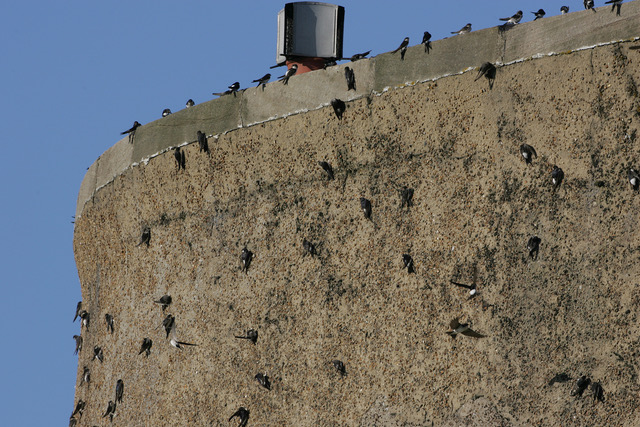
We’ve all noticed that ourselves. Think of the ‘splatter test’ – the number of insects smeared on your windscreen and headlights today, compared to the ‘moth snowstorm’ we used to drive through at night a generation ago. And how we miss what Tennyson happily described as the ‘murmuring of innumerable bees’. But there’s also a new factor now – climate change – and that may cause other dramatic changes. As the world’s climate heats up, the swallows’ journeys back to Southern Africa over barriers like the fast-expanding Sahara Desert become ever more arduous. Suppose the costs of long-distance migration no longer prove worth the physical risks and effort they have to endure. Perhaps the swallows might never come at all one year. Or suppose they were to come and stay over, taking advantage of our milder winters now. If we had swallows at Christmas, what would that do to our emotional responses – to swallows, spring and autumn? Are we at risk of losing the seasons as well as the insects and the birds?
Jeremy Mynott
6th August 2023
All parking at Shingle Street is permissive parking on residents’ land. An area of this parking at the southern end of the hamlet, providing c10 parking spaces, was damaged during the dry summer of 2022 and visitors’ cars were becoming stuck in the shingle, requiring the spaces to be closed.
A Sustainable Development Fund grant from the Suffolk Coasts and Heath AoNB has supported residents to repair the damaged area and reopen the land to parking again.
The work was undertaken by 8 volunteer residents and involved: digging to prepare the ground, the supply and manual raking out of 18 tonnes of aggregate material and, finally, car-rolling to bind the material. It was a good workout for all involved, young and old alike, and, once finished (!), all said they enjoyed completing a great job together.
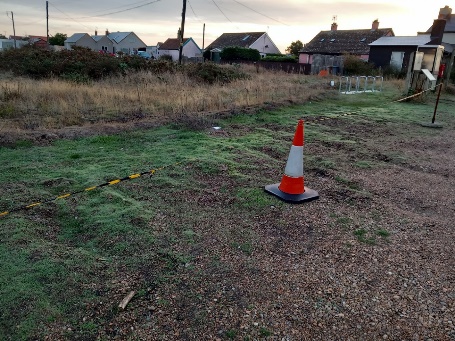
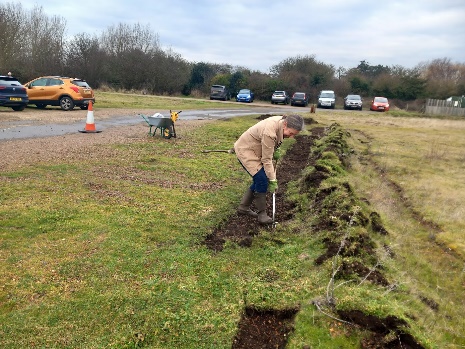
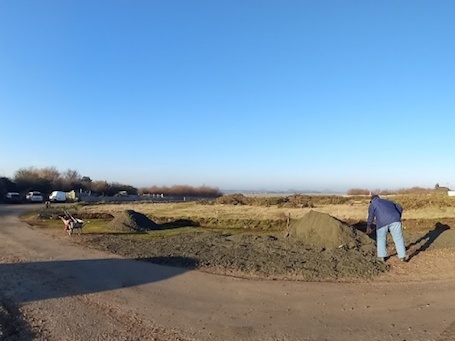
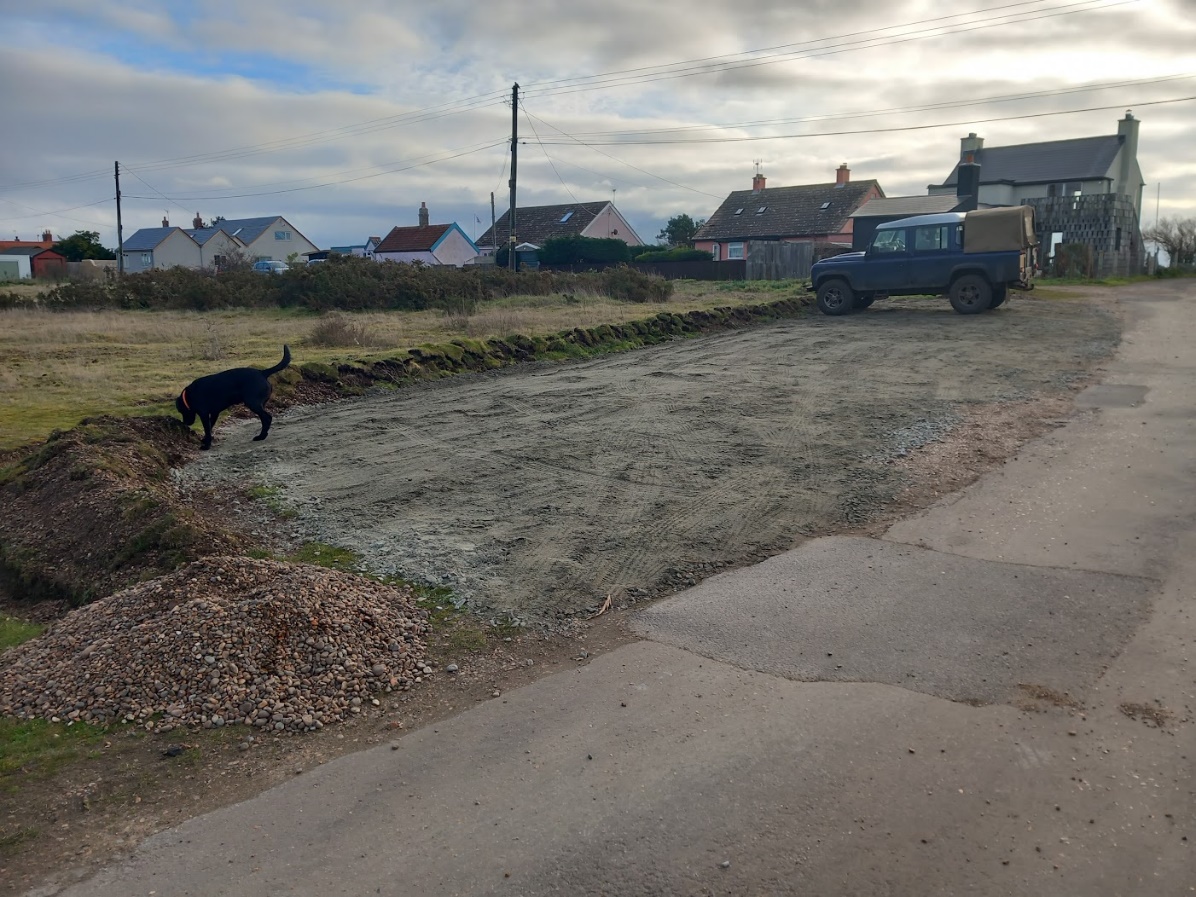
Background: Shingle Street receives in the order of c30,000 – 70,000 visitors every year yet it is one of the most fragile and sensitive areas for biodiversity within the Suffolk Coast and Heaths AoNB. Visitors highly value their experiences at Shingle Street which provides significant wellbeing and tourist public value. Most visits (anecdotal >c95%) are made by car which are only possible thanks to parking areas provided by the residents’ community.
I’m writing this on the fifth of November, having just got in from a long ramble. It’s been a dull, misty day and it was already dusk by 4pm. I was reminded of a gloomy poem by Thomas Hood called ‘November’. You have to read it out loud in an Eeyore voice to get the full, dismal effect:
No warmth, no cheerfulness, no healthful ease,
No comfortable feel in any member –
No shade, no shine, no butterflies, no bees,
No fruits, no flowers, no leaves, no birds –
November
Very evocative – except that it’s all wrong now. You need to remember that poor old Thomas Hood, who died at the age of just 45, wrote this in London in 1844 at a time when the city was often choked with thick smog and winters were much colder than now. None of his examples really apply today. We’ve just had some of the warmest autumn days ever, and I seem to have plenty of feeling left in the members that matter. Moreover, there are still green leaves on the trees. And I had to cut my lawn again last week – unthinkable even 50 years ago, let alone in Hood’s time. I also saw and heard quite a few birds today. Robins, wrens and a song thrush were all singing and the hedgerows were laden with autumn fruits for foraging winter migrants. Amazingly, I even saw a butterfly on the wing, too – a showy red admiral, nectaring on the late-flowering ivy. Indeed, some of last summer’s roses are still in flower, as well as next year’s daphne. It’s all topsy-turvy.
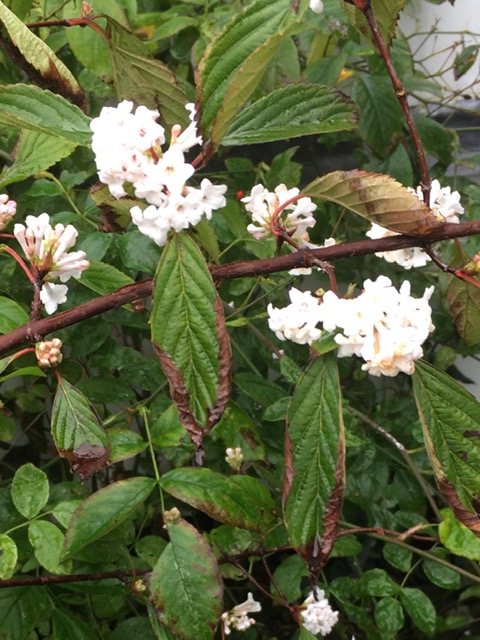
You might think it’s nice to see some life and colour so late in the year, but in truth we know it’s a terrible warning, a disturbance to the natural order that is already a crisis in some parts of the world and is rapidly heading our way. The political news is full of trivial distractions – think no further than the MP for West Suffolk – but there is just one subject that should preoccupy us. It’s the one government leaders are discussing at COP 27 in Egypt as I write. Call it the Environment, Biodiversity, Sustainable Growth or what you wish, but I like the older and richer idea of Nature. No one ever wrote a poem to Biodiversity, but our literature, arts, traditions and whole culture are all saturated with references to Nature as the source of some of our deepest emotions. Not surprising, really, since we are ourselves a part of nature.
So, remember, remember the fifth of November, and put a bomb under the government – just metaphorically, of course.
Jeremy Mynott
5 November 2022
You have to be tough to survive at Shingle Street – if you’re a plant on the shingle banks, that is. Just imagine. You’re regularly doused with salt spray, exposed to constant winds and parched by the sun; there’s no fresh water and almost no soil; while the shingle itself is unstable and constantly shifting. It’s an extreme environment, a desert of stones. Yet there is a community of plants out there that have evolved specialised tactics to cope with those harsh conditions:
We are blessed by our thriving shingle bank colony of these rare and beautiful plants. It’s one of the most important in Britain, which is why Shingle Street is designated an SSSI (Site of Special Scientific Interest). We therefore inspect the plants regularly to check on their condition and a dedicated team of local volunteers has just completed the latest detailed survey, whose results will appear in due course on the Shingle Street website.
We did observe several changes. The sea kale is now very abundant, popping up everywhere like huge cauliflowers. The sea pea has spread too and there are large drifts of it in new areas. Its clustered purple flowers fade to blue later and are then succeeded by succulent seed pods, which are said to have once staved off starvation on the Suffolk coast during a famine in the seventeenth century (but they can cause paralysis if eaten in quantity, just in case you were tempted). Scattered amongst these are other shingle specialists like orache (much scarcer this year), sea beet, sea-campion, curly dock, viper’s bugloss, buckshorn plantain, stonecrop and the striking yellow-horned poppies (beautiful, but classified as a toxic weed in North America, and containing hallucinogens).
The most striking change, however, is in the expansion of the grasses that now cover the shingle ridges nearer the houses. That is evidence that the banks have accumulated depositions of soil and have to that degree stabilised – with the further benefit that hares and skylarks are now exploiting this new emergent habitat, along with various butterflies, moths and bush-crickets. That’s all the more reason to ask visitors to help us conserve this precious environment. For there is one other tactic these vulnerable plants need to survive, this one more under our control than theirs:
Thank you.
Jeremy Mynott
5 July 2022